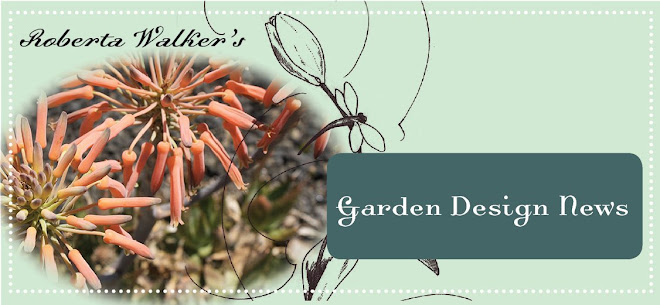Hello Everyone,
I would like to commence this blog with a post on drought tolerant, a subject that has caused quite a stir lately –both in my own work and the general gardening community. After my article came out in Sunset magazine and the spot on News 10 I thought it might be a good idea to share a list of my most frequently used and favorite drought tolerant plants.
A little history...
As a landscape designer I needed to find plants that not only look good and
have a nice form, but also plants that can withstand the heat of the summer
here in Sacramento (which can hit 112F). Many of my clients have had new homes which means no yard and no trees –thus, no shade! Many of the
plants that tolerate high heat happen to be drought-tolerant. It was sort of
a logical step. For me to use plants that require a lot of water and
shade just didn't make sense. And so, over the years I have developed a
plant palate that comprised of plants that looks good, perform well, need very little maintenance and have low water needs.
Most of the plants on this list are also in my yard - I have a very large
yard! If they are not, I make a point of knowing what a plant
will do in our climate by visiting a nursery or planting it. I never simply rely on the plant label.
A drought tolerant plant will exist on one to one and a half gallons of water every three days. A drip system is typically adjusted time-wise with the weather. In the
summer I let my drip system run forty five minutes to an hour every other day. In
the spring this can be every third day. Plants that require more water, roses for example, I will give two drip lines. The trick is to stay away from
overhead sprays - a good percentage of the water will evaporate before it is
able to penetrate to the roots of a plant.
The plants that I have on my Drought Tolerant List are plants that thrive in my growing zone. A zone is defined by elements such as elevation and temperature. In the front of the Sunset Western Garden Guide to Plants there is a good chart of zones. There is also the USDA guide, but I generally stay with the Sunset book.
There are two main sources that I go to for drought tolerant suggestions: Sunset Western Garden and the Xeriscape Plant Guide by Rob Proctor. The Sunset book has a section in that lists plants for dry areas.
Out of all of these plants I have listed here, I have to say that my most trustworthy and favorites are Artemisia, Kniphofia and Salvia.
Artemesia 'Powis Castle' is non-deciduous (does not die back or loose it's
leaves in the winter). You will be surprised at how fast it grows. It is
a bit of a monster when it gets going - give it a lot of room. I generally let
it cascade at the base of landscape boulders. It is a beautiful filler for a
bouquet of cut roses. It is also an herb with quite a fragrant aroma.
Kniphofia - the common name is Red Hot Poker. These plants have a base that
looks a little like agapanthus –green and spiky leaves, but the flower is a tall stem with a torch of red. I like to plant a lot of these in a row so that they create one big
splash when they bloom. In between them I tend to plant Achillea, also known as Yarrow 'Paprika'. The Paprika has fuzzy cream and red blooms grows lower than the Kniphofia, making it a lovely filler. Another great combination is Stipa and Kniphofia. Stipa, or Mexican feather grass, will seed itself all over a yard so in a large area it is perfect to have a drift of the soft grass with the tall blooms of the Kniphofia.
Salvia 'Hot Lips' - What a star performer…This plant blooms beautifully
during the hottest temperatures, mine has lived through a few winters that went down to 24F and was still the first to bloom in the spring. It blooms straight through the summer and finally gives up only after it is well into winter. Salvia Hot Lip is evergreen. If you saw my article in Sunset magazine, this plant is the red blooming in the front of my yard.
Okay, my last plug for drought tolerant. I know this is corny but here it goes: Planting a drought tolerant garden makes sense because it is beautiful and easy to maintain. It makes “cents” because you can potentially save time and money on water and fertilizing (not to mention mowing). Lastly, it makes scents because so many of the drought tolerant plants are fragrant and attract healthy insects, birds and butterflies.
Don’t get me wrong, lawns are lovely too – if you love your lawn but want to cut back on your water usage, try cutting down the lawn area and planting more of these plants. Good luck, I hope this has been helpful!
Wednesday, February 4, 2009
Subscribe to:
Post Comments (Atom)







No comments:
Post a Comment